Q&A – Ask Neil: October 6, 2022
(Please read these instructions carefully.)
Before you post your question, please look at recent issues to see if someone else has already asked it. You might find your answer there.
How to submit your question…
• Click here to post your question.
• After you submit your question, a new window will pop up giving you the address to which you can e-mail a photo to accompany your question. Clear, medium-resolution photos. (Try to avoid low-res thumbnail photos, please, in case I have to zoom in to see things.)
• Please only post your question one time.
• One question per reader, please.
• Please use this only for posting questions – not for standard emails.
• Watch for your answer in the following week’s e-gardens.
• I choose those of greatest general interest. For example, plant IDs seldom make the cut.
• I must have your first name or initials.
• I must have your city or county. (Texas is a very large state.)
QUESTION 1
CAN LEAVES COATED IN HONEYDEW BE USED AS MULCH?
Question: Every year I mulch all my tree leaves and spread them over my natural and planted areas. With all the honeydew this year can I still use them? Do I need to spray the mulch after I spread it? Pat A., Georgetown.
Answer: You can definitely use them, and no, you do not need to spray. The aphids will soon run their course. The overwintering eggs will be laid in fissures in tree bark. (See related story this issue.)
QUESTION 2
WHY ARE LANTANAS TURNING YELLOW?
Question: Why are my lantanas turning yellow? I’ve tried more water and less water, fertilizer, iron applications – nothing seems to help. The plant receives 8-10 hours of direct sunlight daily. Matthew M., Heath.
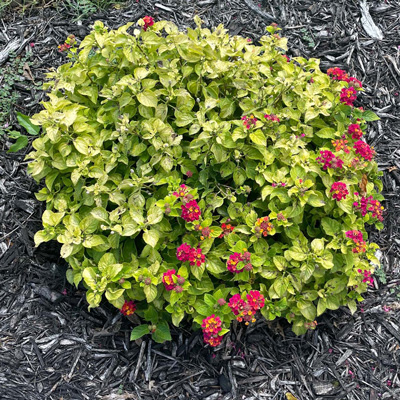
Answer: Look at the backs of the leaves. If you see small black specks, those are excrement of lace bugs. They’re fond of lantanas and, as the season wears on, they can suck the color right out of the plants’ leaves. You can control them with most general-purpose insecticides, although you would want to make your application much earlier in the season than this. If, on the other hand, you don’t see any specks, there must be some type of root problem that is keeping the plant from taking up nutrients properly. However, my money is on the lace bugs.
QUESTION 3
WHY ARE MEXICAN HEATHER PLANTS DYING ONE BRANCH AT A TIME?
Question: Why are my Mexican heather plants dying one branch at a time? Water is consistent along this 40-foot planting, and 5 of the 20 plants are suffering a slow death. A bed of Salvia greggii has the same symptoms. Jeff A., Mansfield.
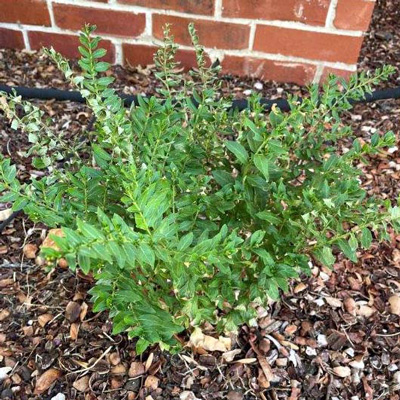
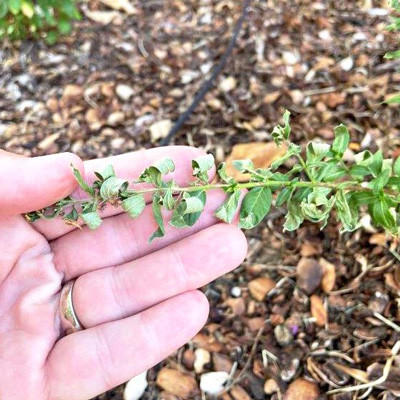
Answer: I’ll take you through my diagnosis process. As soon as you brought Salvia greggii into the discussion, that ruled out diseases. The two species are totally unrelated. That means that it’s highly unlikely that any one disease would attack both plants. And you didn’t mention seeing any insects, so I’ll rule them out, too. That leads us to cultural issues. Either the plants got way too dry one or more times, or they were given too much fertilizer or are suffering a gas leak, weedkiller drift or some other very odd problem. Just because it’s hard to forget the monumental heat and drought we’ve been through, I’m guessed they were involved.
QUESTION 4
SHOULD I LEAVE MORE THAN ONE SPROUT COMING UP FROM ARCTIC FROST SATSUMA?
Question: My Arctic Frost satsuma died in February 2021. Or, so I thought. A few weeks ago it sent up shoots a few inches away from the trunk. Will the tree thrive again? How many trunks should I leave? Carol D., Brenham.

Answer: You need to plant a new Arctic Frost satsuma (bought with a tag attached) next spring. Your sprouts are from the root system and are not Arctic Frost. Your plant was grafted, and these sprouts have originated below the graft union. They are from the original plant’s rootstock.
QUESTION 5
IS EMERALD COLONNADE HOLLY NOT GOOD IN FRISCO?
Question: Is Emerald Colonnade holly not a good choice for Frisco? We’ve lost three in the past year and a half, one during the cold of February 2021 and the others due to heat and drought. One more is barely hanging on. Is there a better shrub of the same shape? Mina C., Frisco.
Answer: It took me a bit of searching, but my friend Siri helped me find the lineage of Emerald Colonnade. Seems it’s a hybrid from the University of Georgia between Ilex crenata ‘Sky Pencil’ and a male form of Ilex maximowicziana. The I. crenata part is enough to tell me that it’s probably not going to be the least bit happy in the Blackland Prairie. Sky Pencil is a disaster waiting to happen in DFW. It’s a shame that nurseries still sell it in where soils are highly alkaline. As for the other species with the unpronounceable name, I have not grown it so I won’t pass judgement. Emerald Colonnade apparently is grown in two forms. One matures at 10 ft. tall and 6 ft. wide, while the other is more columnar. Willowleaf hollies would be perfect for the former. Scarlet’s Peak yaupon, although harder to find, would be better for the latter. I use Oakland hollies where I want a somewhat upright-oval growth form. But I’m having to guess what you want since I can’t see your setting. Take photos of the location to an independent retail garden center in your area and ask them to show you the best options. Also, avoid the upright junipers and Italian cypress due to their susceptibility to diseases.
QUESTION 6
WHAT IS WRONG WITH SUNSHINE LIGUSTRUMS?
Question: Both our new and established Sunshine ligustrums have developed this browning. They have webs, but I can’t see any insects. What is the cause? Jan B., Denton.
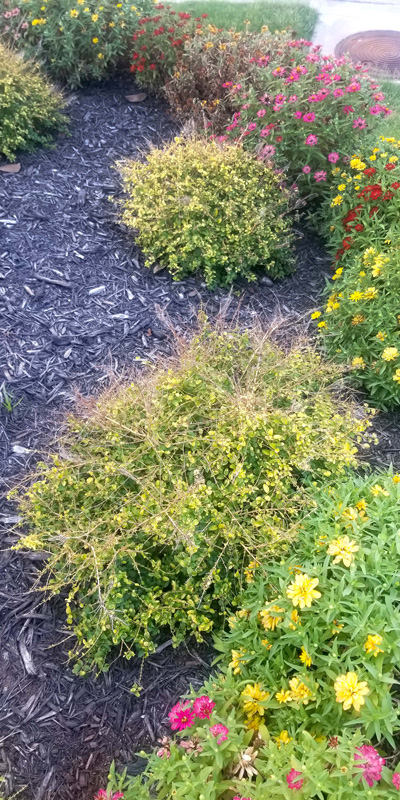
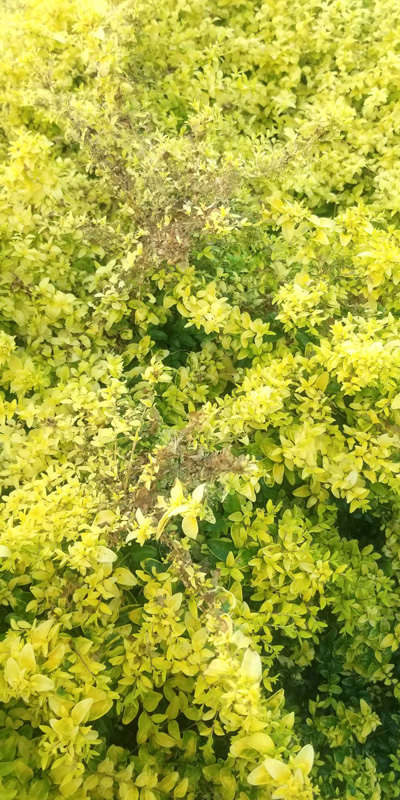
Answer: I’ve been watching Sunshine ligustrums for 6 or 8 years as they’ve become somewhat popular in Texas landscapes. I share the common concern about their possibly reverting to the highly invasive green privet. Green sprouts do pop up all the time and must be removed, but I see no reports of even the green shoots producing fruit. However, the kind of dieback you show has been common in the DFW area where I live and travel. Most of what I’ve seen has been in landscapes where they were either in hot, direct sunlight or where it was difficult to keep them adequately watered during the record heat this summer. The browning happened on leaves that were mostly pale yellow (least able to withstand the sun’s burning rays). I really do think this plant needs to be used in spots that get morning and early afternoon sun, but that have protection from the sun for the hottest hours from 1-5 p.m. It needs rich, moist soils as well. The farther east you go in the state the more forgiving it’s going to be due to the better growing conditions.
QUESTION 7
HOW CLOSE TO THESE STUMPS CAN WE PLANT NEW TREES?
Question: We had two oak trees that did not survive the winter storm of February 2021. We recently had them cut down and the stumps will be ground soon. How close to these stumps should we plant new trees? Should we plant this fall or wait? Diane D., Crockett.
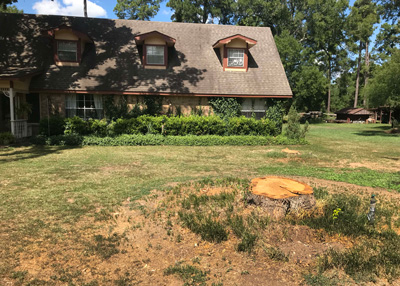
Answer: Fall is a great time for planting, so if you have found a tree that you like, I’d plant it as soon as you have the stump ground out. However, several additional thoughts become very important. Have the company with the stump grinder go far enough into the ground to remove the lateral roots several feet in each direction. They will be large, and they would present a great deal of decaying organic matter that could hinder normal growth of the new tree. Second, get all the shavings out of the way. Use them in your compost pile. Just don’t leave them in the hole. They will tie up available nitrogen for your turf and for the new tree. Finally, your new tree should not go back into the same hole. Ideally, you’ll be able to move it 8 or 10 feet away and still have a good look to your landscape. I can’t tell from your photo exactly where that might be. You can probably tell. If you’re having trouble, set a large box in several places and walk around the yard looking from different angles.
QUESTION 8
WILL BAGWORMS KILL BOIS D’ARC TREES?
Question: What is your take on bagworms on bois d’arc trees? Will the trees survive? Scotty M., Denton.
Answer: Without a photo I don’t know if you’re talking about bagworms (finger-sized, look like small hanging Christmas ornaments) or webworms (look like large, messy spider webs draped over branches). Frankly, I’ve never seen either be much of a problem with bois d’arcs (also called osage oranges or hedge apples). Neither would cause any concern at all.
QUESTION 9
HOW IS CLOVER AS A LAWN SUBSTITUTE?
Question: Please comment on growing clover as a lawn cover. I’m considering it since it doesn’t require as much water, obviously no weedkiller expense and grows where grass won’t grow. Lori W., Watauga. (Similar question posted by Prakash V., Carrollton.)
Answer: I wonder about the coincidence that two people have asked this same question – first time I’ve had it posed to me in all these years. Perhaps something has recently been written about the topic.
The statements you made about benefits of clover push the limits rather extravagantly. Its water consumption will depend on the type of clover, time of year, type of soil, sun exposure and other factors. “No weedkiller expense” is because you can’t use broadleafed weedkillers in a planting of clover. They would also kill the clover. But what do you do if you get an outbreak of poison ivy, dandelions, thistles or brambles? Not to mention Johnsongrass or bermuda. “Grows where grass won’t grow” really stretches it. Clovers require sunlight just like turfgrass. I would guess that their requirements are just about parallel.
Taking the opposite stance, clovers would be attractive for pollinators. And they would cut down on need for fertilizers. They are legumes, so they can convert nitrogen from the air in the soil directly into nutrient nitrogen for their own use and for the consumption of other plants that share the same soil with them.
But how well will clover survive hot, sunny lawns in Texas? Perhaps not too well, especially if they’re subjected to traffic from kids and pets. Google the topic using key words “university clover as lawn substitute” and see how many real matches you get. I got one from Purdue and one from Illinois. I didn’t find any from a southern state where St. Augustine and bermuda are grown.
You asked my opinion. If clover were a reliable lawn substitute we’d already be seeing a lot more of it in Texas. If you still decide to try it, I would strongly recommend that you give trial to a card table-sized space way out back in your landscape for a couple of years. See if you’re really as satisfied with it as all those sales websites would have you believe.
QUESTION 10
ANY ADVICE FOR A STAPELIA (STARFISH FLOWER) GROWER?
Question: I got a starfish flower from Florida last spring. It has multiplied and flowered. I’m not sure what I did right, so I’d love any advice you might have. What winter care does it need? Julie N., Mansfield.

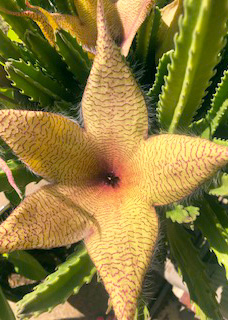
Answer: I’m flattered you would ask since you’re obviously doing very well. This amazing group of plants out of the Milkweed family has always been one of my favorites. At one point I had perhaps 35 different species of stapelias and huernias.
I guess you know that they have the putrid odor of their flowers because they are pollinated by flies, hence their other common names of carrionflower and dead mule cactus.
They need porous potting soil and bright light but no direct afternoon sun in the summer. I keep mine at 55 degrees minimum in the winter, preferably warmer. I am very conscious not to overwater them. If in doubt, I let them go one or two more days before watering. Watch closely for mealybugs – the only pests I’ve ever seen bother them. I daub them off with a Q-tip dipped in rubbing alcohol.
